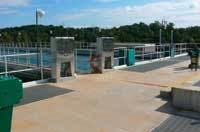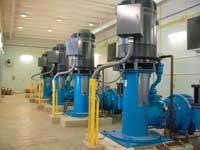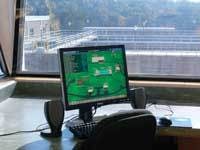by Grant Van Hemert
Like many small suburban communities, the city of Easley, SC, experienced steady population growth from 1970 to 2005. By 2004, the city had seen a 67% increase in its population, bringing the total to more than 18,500 people. In addition to serving the residents of Easley, the city’s utility company, Easley Combined Utilities (ECU), supplies water to four neighboring water districts which accounted for approximately 46% of water sales by volume in fiscal year 2006.
Easley Combined Utilities used a Telemecanique® brand Modicon® QuantumTM programmable logic controller from Schneider Electric for the chlorine disinfection control panel at the Don L. Moore water treatment plant.
ECU’s 9 mgd Don L. Moore Water Treatment Plant had gone 35 years without an upgrade and the city wanted to make some changes. According to ECU, providing a reliable source of water to its residents and the four area districts was crucial in the decision to expand the existing plant. Not only did ECU need more capacity, management also wanted more accurate data and the equipment to be more accessible. The water treatment plant has five operators. With the plant having to run 24 hours a day, seven days a week, many times there was only one operator per shift. Due to the limited staff, ECU sought improved monitoring capability.
ECU embarked on a 20-month project to upgrade the facility to 12 mgd. Using a prequalification process, ECU turned to M/R Systems, an instrumentation and control system integrator with extensive experience in the water and wastewater industries, for an integrated automation and control, and power distribution solution. M/R Systems provides state-of-the-art open instrumentation and control systems using off-the-shelf components and industrial monitoring and control software. The company collaborated closely with Design South Professionals, the consulting engineering firm that designed the system, to provide ECU with a unified, open and commercially available solution.
Going Automated
Using a collaborative process, Design South and M/R Systems recommended ECU install a supervisory control and data acquisition (SCADA) system. M/R Systems proposed a control system based on the Telemecanique® brand Modicon® QuantumTM programmable logic controllers (PLC) from Schneider Electric. The PLCs were programmed with the ConceptTM line of development software and were installed throughout the plant to control a variety of processes including chemical feed, rapid mixing, raw water, finished water and filters. The software allowed M/R Systems to modularize and repeat some of the programming amongst the PLCs.
With PLCs gathering information and a SCADA system analyzing it, the ECU operators have more accurate, up-to-the-minute information that affords them more overall system knowledge and tighter control capability.
“With the automated system, if we have a problem with a chemical feed, a pump, anything, we have almost immediate acknowledgement of it,” said Tate Davis, water plant superintendent, Easley Combined Utilities. “Before, we had to run hourly manual checks on everything, including the water itself, and it could be 2-3 hours before we would catch a problem. We spend a lot less time physically checking on the equipment, monitoring tank levels or calculating chemicals pumped. Now, the SCADA system tells us all of that.”
To maximize ECU’s use of the SCADA system, M/R Systems installed thin-client, touch screen control panels throughout the plant, allowing operators full access to the SCADA system. ECU personnel interface with the system through the open architecture graphic touch screen terminals. Since operators are never far from a control screen and the system, if an alarm goes off, they can respond immediately. All of the screens in the plant are identical to the one in the control room, and allow the operator to perform all the same functions. With a 20-acre plant and a small staff, it was essential for ECU to have constant access to the control system without dedicating an operator to the control room at all times.
The SCADA system also is connected to six remote telemetry unit (RTU) stations that monitor the water distribution network, providing operators further access to the control system. As is the case with most RTU stations, the Easley units were unmanned. The SCADA system, however, allows operators to monitor activities at the RTUs without visiting them.
“The SCADA system has provided us with immense value,” said Davis. “Now, all we have to do is press a button to start up and shut down the different areas of the plant. This saves us a tremendous amount of time every day.”
The upgraded plant also contains one self-healing fiber optic Ethernet ring network where all of the automation equipment resides, including the SCADA system, PLCs and an in-plant camera network. The five Ethernet cameras are scattered around the entire treatment plant and allow operators to visually observe everything going on without leaving the control room. The Ethernet ring is able to house all of the equipment, including the cameras, without any bandwidth or communication issues.
ECU opted to install a SCADA system at its treatment plant. Operators now have more accurate, up-to-the-minute information that affords them more overall system knowledge.
In addition, ECU staff can remotely monitor the plant thanks to integration with the Internet through a virtual private network (VPN). A VPN connection creates a secure communication tunnel through the Internet, allowing operators to access and adjust parameters in the site remotely without exposing the plant to harmful viruses and hacker attacks. In addition, it allows the city to properly monitor all aspects of the plant via both data and visual means by way of a remote location. In addition, the VPN network allows the system integrator to inspect the system before sending a technician to the site for service. Often times, an inspection remotely can solve the problem and prevent the need to send someone. Fewer trips to the facility saves the city maintenance costs and overtime charges by city personnel.
It was especially important to Easley that the automation and control solution be open. M/R Systems felt comfortable recommending a Schneider Electric automation and control system because it was a non-proprietary, open solution with open Ethernet protocols. Special drivers and proprietary software are not needed to see system information. For ECU, complete access to all plant information is easily accessible through off-the-shelf software packages.
Reliable Power Distribution
ECU elected to use Square D® brand power distribution equipment from Schneider Electric, ensuring seamless, open communication and system compatibility both now and during future upgrades.
The utility used Square D power distribution products in the plant when it was first built and was pleased with the products’ reliability, functionality and performance. After M/R Systems recommended a Schneider Electric automation and control solution, it made even more sense to have one company offering a unified solution.
The raw water building contains Square D QED switchgear, three Square D Class 8839 drives with Altivar® 58 technology, and a Square D Model 6 motor control center (MCC). The QED switchgear sends power to the four drives, the MCC, and the Square D transformer used to derive 120 vAC for the Square D panelboard. The panelboard provides protection for the PLC panel, instruments and general building power. The drives are used for the four raw water pumps that bring water from the nearby river.
“Using the variable speed drives for our raw water intake is especially valuable because it allows us to control the flow without having to completely start up and shut down a pump every time we need to change loads,” said Davis. “We change the plant load about 3-4 times per day. Now, we can just rotate the speed to accommodate the flow required and we let the system run. This equates to a tremendous time savings in not having to start up and shut down the plant.”
The access corridor next to the flocculators consists of Square D QED switchgear that distributes power to two Square D Model 6 MCCs, and a Square D transformer. Each MCC is located inside a rainproof enclosure. The MCCs house the flocculation drives, unit heaters, and other small motors located in the area. The transformer supplies power to the Square D panelboard. This panelboard provides protection to the lights, instruments and PLC in the area. Square D safety switches are used throughout the plant for the local disconnect stations when maintenance is required.
Unified System
M/R Systems found that the integration of the automation and control and power distribution systems went very smoothly and provided a highly coordinated solution that was easy to use.
“Another vendor could come up with the same pieces as what Schneider Electric provided, but the whole system wouldn’t be as integrated or work as seamlessly,” said Jim Bercik, president, M/R Systems.
ECU finds value in having a single manufacturer’s equipment for the automation and power distribution systems. Not only has the solution proven to be exceptionally reliable and user-friendly, but the unified system also is easier to troubleshoot and maintain. More importantly, when support is needed for either system, ECU operators only need to make one call for service.
“When we need support it’s all coming from the same place,” said Davis. “It’s nice to make just one call instead of calling three different people to fix three different problems. The support we get from our local representative is outstanding.”
Easley is assured future cost savings since both systems are completely open and compatible, ensuring future upgrades will be just as seamless. In addition, all of the equipment communicates openly with other vendors’ equipment.
Looking to the Future
ECU completed its plant upgrade in July 2005. The utility now can properly monitor all aspects of its plant via both data and visual means. The switch to automation also helped Easley handle the plant’s increased capacity without needing to hire additional staff, saving the community money. ECU also is saving material costs and realizing electricity savings since it now has the ability to optimize its chemical usage and take advantage of off-peak electricity hours. The utility also has increased its water quality by more than 50 percent thanks to the automated system’s tighter control capabilities.
About the Author:
Grant Van Hemert is an automation and control applications engineer for the Schneider Electric Water Wastewater Competency Center. Van Hemert has over 11 years of water and wastewater experience. Previously he was a design and implementation engineer where he designed and commissioned automation and instrumentation systems dealing with aeration, screening, and clarification.






